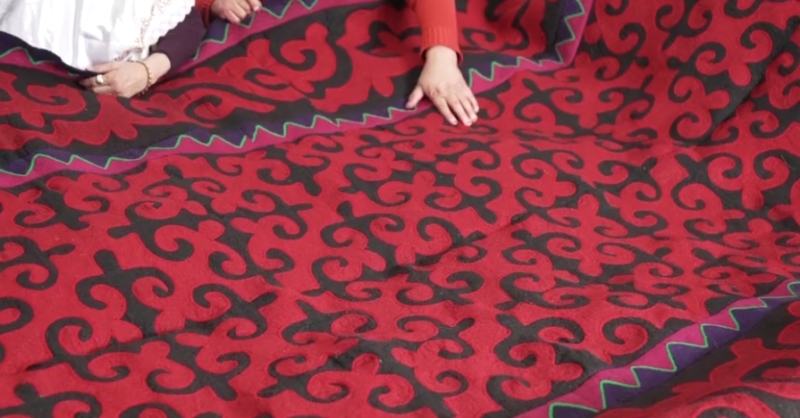Felt carpet is an indispensable handicraft and daily necessities for the Kirgiz people in their daily lives. In Qibaltale Village, Kuoketiereke Kirgiz Township, Tekes County, Ili Kazak Autonomous Prefecture, northwest China's Xinjiang Uygur Autonomous Region, almost every Kirgiz woman can make exquisite felt carpet. And Guljan Kazakbai is one of them.
Walking into Guljan’s home, one will be attracted by the colorful and exquisite felt crafts. The pattern of the felt carpets has a geometric symmetrical shape in the center, surrounded by sheep horn shaped patterns. It is colourful and exquisite.

Photo shows a Kirgiz felt carpet.
This kind of felt carpet, also known as "Srdak" in Kirgiz language, is widely used in the daily lives of the Kirgiz people. Kirgiz people would not only hang felt carpet on the door of their yurt, but also lay felt carpet on the seat cushions and bed. When a girl gets married, felt carpet is also part of the dowry.
"When we got married, my mother made two felt carpets for each of us," Turhongnayi Akaijan, the daughter of Guljan Kazakbai, said.
Guljan Kazakbai, who is 60 years old this year, is one of the felt carpet craftsmen in the village. She started making felt carpets at the age of 20 and supported her children's education and built her own house for 40 years by the income of making felt carpet. Guljan Kazakbai said, "There are no samples or drawings of the patterns, all the patterns are in our minds." She picked up a chalk and drew patterns on the felt.
Turhongnayi Akaijan, the daughter of Guljan Kazakbai, has been watching her mother make felt carpets since childhood, and now she knows the process of making felt carpets very well.

Photo shows Guljan Kazakbai uses chalk to draw on the felt.
Turhongnayi Akaijan said, "This is Kirgiz felt carpet. We are currently doing collaging work. Firstly, we wash the wool and make it into felt, then color it and cut it out. The whole process will take about a month.”

Photo shows a craftsman twists wool thread.
Most felt carpet is double-layer, with dense stitching, which is durable and can be used for over a hundred years. Due to differences in location and villages, the form and pattern of felt carpet are also different. The exquisite quality of felt carpet depends on the quality of wool. The finest wool is produced in autumn, which is exquisite and soft. People need to cooperate with each other in the process of rolling and sewing.

Photo shows felt carpet craftsmen loose the wool.
"The felt carpet that my mother made is four meters long and two and a half meters wide, which is priced at 4,000 yuan (about 555 U.S. dollars). When making felt carpet, our families, neighbors and friends will come to help. This felt carpet is made in a month. My mother's annual income is about 20,000 yuan (about 2774 U.S. dollars)," Turhongnayi Akaijan told reporters.
According to Turhongnayi Akaijan, nowadays more and more people are attracted by handmade and exquisite felt carpet. She said that she often makes felt carpet with her mother and aunts in her spare time, and she hopes to pass on this craft.

Photo shows Turhongnayi Akaijan makes felt carpet with her families.
Turhongnayi Akaijan said “I want to learn from my mother and pass on this craft.”
In recent years, In order to protect and inherit the folk handicrafts passed down by the Kirgiz, Kuoketiereke Kirgiz Township in Tekes County has been actively promoting felt carpet making technique, and has taken multiple measures to encourage and support farmers and herdsmen to make traditional handmade felt carpet products, so as to increase villagers’ income while protecting and inhering traditional crafts.
(The Media Convergence Center of Tekes, Reporters: Hai Ri, Zhang Zhengbin)









